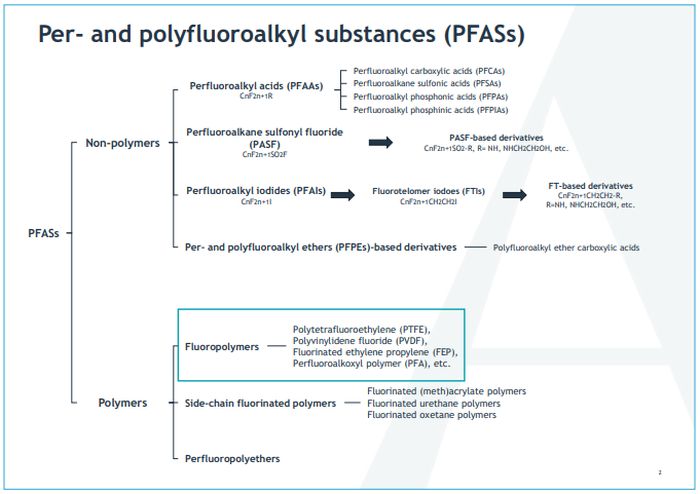What Are Fluoropolymers?
To understand fluoropolymers, one must first understand PFAS. PFAS are a broad class of chemicals for which there is no single, globally harmonized definition. Many regulations define PFAS based on their structure and atomic composition and specifically the carbon–fluorine (C–F) bond found in all PFAS. A definition used in several federal and state regulations within the United States, for instance, describes PFAS as a "class of fluorinated organic chemicals containing at least one fully fluorinated carbon atom." Such broad, chemical structure-based definitions, however, cover a range of about 9,000 substances, which can vary greatly in risk presented and toxicological profiles. Such a structural definition that includes PFAS of Concern or PFOC like the toxic, bio-accumulative, persistent and mobile per- and polyfluoroalkyl carboxylic and sulfonic acids (example: PFOA and PFOS) also brings within its purview of regulation fluoropolymers—a distinct class of 38 PFAS used primarily in industrial applications that can be produced, used and disposed of safely.

Why Do We Need Fluoropolymers?
Fluoropolymers are essential to several critical industrial sectors including renewable energy, transportation, electric vehicles, semiconductors, food and water treatment technologies, safe chemical processing, and pharmaceutical and medical devices.1 In October 2023, the Department of Defense (DOD) submitted a "Report on Critical Per- and Polyfluoroalkyl Substance Uses" to Congressional Committees outlining uses of PFAS, and especially fluoropolymers, that are critical to the national security of the United States. The Report warns against chemical-structure-based (rather than hazard- or risk-based) definitions that would unwisely target fluoropolymers without regard to the specific risk (or lack thereof) relative to their use. Similarly, a regulatory management option analysis (RMOA) published by the United Kingdom's Health and Safety Executive (HSE) in April 2023 suggests that the current regulatory framework for PFAS in the U.K. could be streamlined by providing exemptions for fluoropolymers and fluoroelastomers since comprehensive, reliable evidence of their low hazard or safe use is available, and because they are particularly important to the industrial, automotive, aerospace and defense sectors.
How Are Fluoropolymers Different from PFAS of Concern?
While fluoropolymers share structural similarities with other PFAS, this structural similarity—namely the existence of a single C–F bond across chemical substances—in itself is not representative of a risk to human health and environment. Whether a PFAS is a cause of concern to human health and environment is determined by other traits such as its potential to bio-accumulate and to be persistent and/or mobile in the environment. Fluoropolymers exhibit different toxicological and environmental profiles from PFOC in these regards. They are high molecular weight substances with negligible solubility in water, solvents and biological liquids that cannot bio-accumulate in the human bloodstream. Further, they do not degrade to PFOC under intended use conditions or under the environmental conditions at the end-of-life phase of their application. Fluoropolymers are non-mobile, non-bio-accumulative, non-toxic chemicals that do not pose any risk to water quality, human health or the environment and fulfill the 13 criteria established by the Organization for Economic Cooperation and Development (OECD) to be regarded as "Polymers of Low Concern."
"Fluoropolymers are non-mobile, nonbio-accumulative, non-toxic chemicals that do not pose any risk to water quality, human health or the environment..."
To the extent there may be a valid concern related to fluoropolymers, it is the use and potential emission of fluorinated surfactants (also called PFAS polymerization aids) in the polymerization of certain fluoropolymers. However, the four fluoropolymers which form majority of the fluoropolymers in circulation in commerce—polytetrafluoroethylene (PTFE), polyvinylidene fluoride (PVDF), fluoroelastomer (FKM) and perfluoroalkoxy alkanes (PFA)—can be produced without the use of fluorinated surfactants and many companies are already doing so or committed to doing so.
Federal Fluoropolymer Activity
The U.S. Congress is considering legislation in a number of areas that affect fluoropolymers, including those that do so in the greater context of regulating PFAS.
In July 2023, the Senate Environment and Public Works (EPW) Committee released a draft bipartisan PFAS bill aimed at mitigating and remediating PFAS contamination. The draft proposed a deadline for the Environment Protection Agency (EPA) to set a Safe Drinking Water Act (SDWA) standard for PFAS, provided additional funding for research and treatment technology, addressed PFAS in the context of the Comprehensive Environmental Response, Compensation and Liability Act (CERCLA) and, perhaps of greatest importance to fluoropolymers, proposed a definition for PFAS which, although structural, is more narrowly tailored to target toxic PFAS that are mobile in the environment. The definition targets only non-polymeric PFAS and human-made side-chain fluorinated polymers containing at least two fully fluorinated carbon atoms. It exempts fluoropolymers, which are polymeric, and thus have a higher molecular mass, making them less mobile in the environment. Fluoropolymers also differ from side-chain fluorinated polymers; unlike fluoropolymers, side-chain fluorinated polymers can degrade to non-polymeric PFAS during their intended use or at the end-oflife phase and are used for more dispersive consumer facing applications. The draft was the product of science-based stakeholder input and a receptive, bipartisan EPW Committee leadership and staff. At this writing, EPW Committee leaders have yet to indicate when they will officially introduce the PFAS bill, nor are its prospects for eventual consideration and adoption clear at this time.
EMPW Committee Bipartisan PFAS Bill
- Proposed a deadline for the Environment Protection Agency (EPA) to set a Safe Drinking Water Act (SDWA) standard for PFAS.
- Provided additional funding for research and treatment technology
- Addressed PFAS in the context of the Comprehensive Environmental Response, Compensation and Liability Act (CERCLA).
- Proposed a definition for PFAS more narrowly tailored to target toxic PFAS that are mobile in the environment.
The fiscal year (FY) 2023 National Defense Authorization Act (NDAA) required the DOD to submit a report to the Senate and House Armed Services Committees on DOD's use of PFAS "critical to the national security of the United States," with a focus on sectors of strategic importance for domestic production and supply chain resilience. In response, DOD recently submitted a report to the House and Senate Armed Services Committees emphasizing, in part, that "a dozen fluoropolymers, including fluoroelastomers, are ingredients in polymer bonded explosives, pyrotechnics, and propellant components used in munitions, decoy flares, and chaff," noting that fluoropolymers "serve as high temperature resistant binders and resins." In addition to these few "purely military PFAS applications," the report also underscored defense applications equally critical for non-defense, civilian needs, such as energy storage and electric vehicle batteries. The report recommends more careful PFAS regulation that contemplates these critical applications, discouraging the use of broad chemical-structure-based definitions and advocating instead for regulations that are hazard- or risk-based.
Additionally, the Department of Energy (DOE) is assembling a report in response to a directive contained in the FY 2023 Energy and Water Development and Related Agencies Appropriations Act to provide a life-cycle assessment of fluoropolymers within a year of its enactment. Among other elements, the law calls for "an analysis of the use of fluoropolymers in the aerospace, automotive, battery, building construction, chemical processing, electronics, infrastructure, semiconductor, solar panel and wind energy sectors." DOE, in collaboration with Savannah River National Laboratory and Vanderbilt University, sought extensive stakeholder input to inform the DOE report due to Congress in April 2024.
To view the full article click here
Footnote
1. Fluoropolymers are crucial to, and irreplaceable in, the manufacturing of solar panels and windmill blades for clean energy systems. In electric vehicles, fluoropolymers are critical for optimal performance of lithium-ion batteries and hydrogen fuel cells. Fluoropolymers are essential for manufacturing semiconductors. Without fluoropolymers, the semiconductor industry will be unable to produce microchips that allow for the development of modern electronic devices such as mobile phones and laptops. Fluoropolymers are utilized in water filtration systems (which avoids the need to use chemicals for water treatment), and in food processing systems to guarantee adequate sanitary conditions and protect consumers from harmful contamination. Catheters and medical implants contain fluoropolymers due to their biological compatibility, inertness and durability. Furthermore, the production of medicines and vaccines requires ultra-pure conditions which can only be achieved with equipment based on fluoropolymer materials. Fluoropolymers are found in all kinds of industrial equipment, as well as joints and gaskets to secure operation and containment of chemicals. Further, fluoropolymers contribute to both fuel efficiency and safety, playing a key role in systems such as brakes in cars or wing flaps in aircraft. They are also the best option available (due to their high resistance and high flexibility) to protect electrical cables in aircraft, where high reliability of such cables, which can be exposed to thermal as well as chemical pressure, is fundamental. Lastly, fluoropolymers are used in highly efficient air conditioning and refrigeration systems, as well as in heat pumps. Fluoropolymers also play a key role in modern construction systems, used in many buildings to boost durability and sustainability.
Sources: https://www.gfl.co.in/assets/pdf/GFLAnnouncement30.11.22_new.pdf, https://www.solvay.com/en/innovation/science-solutions/pfas , https://www.arkema.com/global/en/media/newslist/news/global/corporate/2023/20230221-arkema-position-on-european-proposal-to-restrict-pfas/
The content of this article is intended to provide a general guide to the subject matter. Specialist advice should be sought about your specific circumstances.








